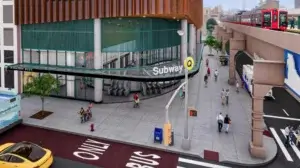Decades after elevated highways were run through some of America’s largest cities in the name of “urban renewal,” severing low-income communities (often of color), the growing pushback from communities on the ground to “redress historic inequities” has led to federal and state funding to do exactly that. From a stretch of Interstate 5 in Portland, Oregon, that runs through its Central Eastside neighborhood to the elevated I-345 highway that bisects Dallas’s Deep Ellum community, plans are in the works to demolish, cover, or repurpose such roads across the country.
Built in 1957, Syracuse’s I-81 cut through the city’s urban core and caused a mass migration from downtown; even today, most of Syracuse’s wealth is concentrated in its suburbs, not the city proper. But, with a 1.2-mile-stretch of elevated highway dubbed The Viaduct approaching the end of its useful life, residents and the New York State Department of Transportation (NYSDOT) have been debating what to replace it with for the better part of a decade.
Three options have been on the table for what would happen once the elevated highway is pulled down: replace it with an underground tunnel, rebuild a similar viaduct, or lay down a slower, pedestrian-friendly street grid that would possibly bring some life back to downtown Syracuse.
While former New York Governor Andrew Cuomo anticipated demolition of that stretch of I-81 would begin sometime in 2022, current Governor Kathy Hochul is moving ahead with concrete plans to take down five such dividing roadways across the state.
On January 22, Hochul announced that the state would be putting $3 billion over the next five years towards pulling down World War II-era highway expansions and reknitting the communities they tore apart.
“Reconnecting neighborhoods that were severed by asphalt highways is a cornerstone of our bold infrastructure vision for a better New York,” Governor Hochul said. “Better infrastructure means better quality of life, and the communities around the Kensington Expressway in Buffalo and across our state deserve nothing less. These projects will help right the wrongs of the past through safer and reliable transit networks, landscapes designed to bring communities together, and routes that are friendlier for pedestrians and bikers.”
To that end, the state is moving ahead with the last of the three aforementioned options for the elevated section of I-81 in Syracuse: replacing it with a “Community Grid” of streets optimized for local traffic and complete with new green space and pedestrian and bike access.
A similar story will unfold in Buffalo, where the below-grade Kensington Expressway cuts through the Frederick Law Olmsted-designed Humboldt Parkway and surrounding neighborhoods. NYSDOT will now work with the Federal Highway Administration on the environmental review process as the state undertakes a public scoping to determine how to safely reroute the 80,000 daily cars the expressway carries to local streets while also improving the surrounding public realm.
In addition to Syracuse and Buffalo, three other major revitalization projects are also underway across the Empire State. One is in Rochester and two are in the Bronx, where the Cross-Bronx Expressway will be covered and polluting truck traffic that has long clogged local streets in the South Bronx will be reduced through the construction of new entrances to the Bruckner Viaduct.











